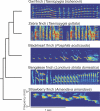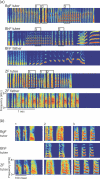Coevolution in communication senders and receivers: vocal behavior and auditory processing in multiple songbird species
- PMID: 21535002
- PMCID: PMC3282583
- DOI: 10.1111/j.1749-6632.2011.05989.x
Coevolution in communication senders and receivers: vocal behavior and auditory processing in multiple songbird species
Abstract
Communication is a strong selective pressure on brain evolution because the exchange of information between individuals is crucial for fitness-related behaviors, such as mating. Given the importance of communication, the brains of signal senders and receivers are likely to be functionally coordinated. We study vocal behavior and auditory processing in multiple species of estrildid finches with the goal of understanding how species identity and early experience interact to shape the neural systems that subserve communication. Male finches learn to produce species-specific songs, and both sexes learn to recognize songs. Our studies indicate that closely related species exhibit different auditory coding properties in the midbrain and forebrain and that early life experience of vocalizations contributes to these differences. Moreover, birds that naturally sing tonal songs can learn broadband songs from heterospecific tutors, providing an opportunity to examine the interplay between species identity and early experience in the development of vocal behavior and auditory tuning.
© 2011 New York Academy of Sciences.
Figures




Similar articles
-
Developmental experience alters information coding in auditory midbrain and forebrain neurons.Dev Neurobiol. 2010 Mar;70(4):235-52. doi: 10.1002/dneu.20783. Dev Neurobiol. 2010. PMID: 20039264 Free PMC article.
-
Songbirds can learn flexible contextual control over syllable sequencing.Elife. 2021 Jun 1;10:e61610. doi: 10.7554/eLife.61610. Elife. 2021. PMID: 34060473 Free PMC article.
-
Early experience shapes vocal neural coding and perception in songbirds.Dev Psychobiol. 2012 Sep;54(6):612-31. doi: 10.1002/dev.21014. Epub 2012 Jun 18. Dev Psychobiol. 2012. PMID: 22711657 Free PMC article. Review.
-
Conserved mechanisms of vocalization coding in mammalian and songbird auditory midbrain.Hear Res. 2013 Nov;305:45-56. doi: 10.1016/j.heares.2013.05.005. Epub 2013 May 31. Hear Res. 2013. PMID: 23726970 Free PMC article.
-
From Perception to Action: The Role of Auditory Input in Shaping Vocal Communication and Social Behaviors in Birds.Brain Behav Evol. 2019;94(1-4):51-60. doi: 10.1159/000504380. Epub 2019 Dec 5. Brain Behav Evol. 2019. PMID: 31805560 Review.
Cited by
-
Integrative studies of cultural evolution: crossing disciplinary boundaries to produce new insights.Philos Trans R Soc Lond B Biol Sci. 2018 Apr 5;373(1743):20170048. doi: 10.1098/rstb.2017.0048. Philos Trans R Soc Lond B Biol Sci. 2018. PMID: 29440515 Free PMC article.
-
Auditory Selectivity for Spectral Contrast in Cortical Neurons and Behavior.J Neurosci. 2020 Jan 29;40(5):1015-1027. doi: 10.1523/JNEUROSCI.1200-19.2019. Epub 2019 Dec 11. J Neurosci. 2020. PMID: 31826944 Free PMC article.
-
Functional plasticity of the swim bladder as an acoustic organ for communication in a vocal fish.Proc Biol Sci. 2023 Dec 20;290(2013):20231839. doi: 10.1098/rspb.2023.1839. Epub 2023 Dec 13. Proc Biol Sci. 2023. PMID: 38087920 Free PMC article.
-
Auditory-vocal coupling in the naked mole-rat, a mammal with poor auditory thresholds.J Comp Physiol A Neuroethol Sens Neural Behav Physiol. 2018 Nov;204(11):905-914. doi: 10.1007/s00359-018-1287-8. Epub 2018 Sep 19. J Comp Physiol A Neuroethol Sens Neural Behav Physiol. 2018. PMID: 30232547 Free PMC article.
-
Experience-dependent overrepresentation of ultrasonic vocalization frequencies in the rat primary auditory cortex.J Neurophysiol. 2013 Sep;110(5):1087-96. doi: 10.1152/jn.00230.2013. Epub 2013 Jun 5. J Neurophysiol. 2013. PMID: 23741037 Free PMC article.
References
-
- Sherman P, Reeve H, Pfennig D. Recognition systems. In: J. K, Davies NB, editors. Behavioral Ecology. Blackwell Science; Malden, MA: 1997.
-
- Ryan MJ. Sexual selection, receiver biases, and the evolution of sex differences. Science. 1998;281:1999–2003. - PubMed
-
- Bradbury JW, Vehrencamp SL. Principles of Animal Communication. Sinauer Associates; Sunderland, MA: 1998.
-
- Searcy WA, Nowicki S. The Evolution of Animal Communication: Reliability and Deception in Signaling Systems. Princeton University Press; Princeton, NJ: 2005.
-
- Endler JA. Some general comments on the evolution and design of animal communication systems. Philos Trans R Soc Lond B Biol Sci. 1993;340:215–225. - PubMed
Publication types
MeSH terms
Grants and funding
LinkOut - more resources
Full Text Sources

